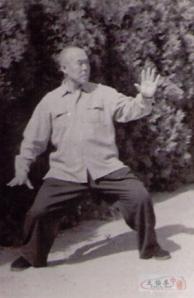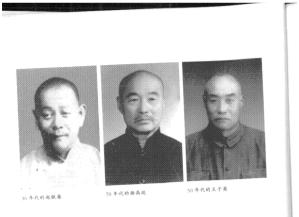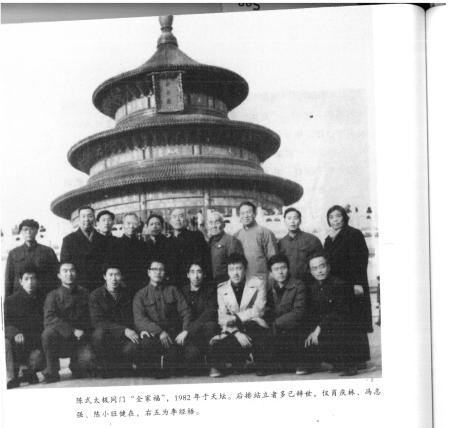Lives of the Chinese Martial Artists (9): Woman Ding Number Seven: Founder of the Fujian Yongchun Boxing Tradition by
benjudkins
Found:
HERE
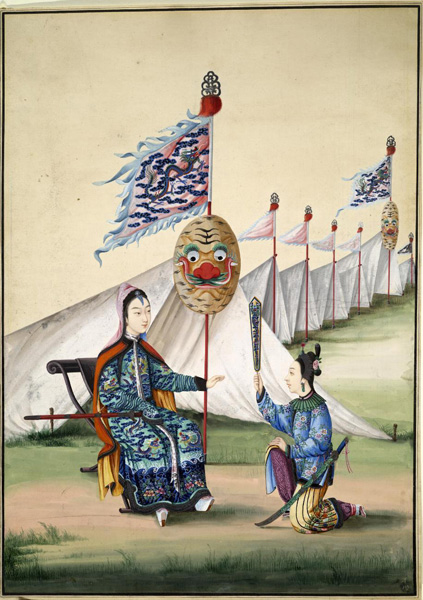
Qing era painting of a general’s wife and her female retainer. Source: New York Public Library, electronic collection.
Introduction: Gender and the History of the Chinese Martial Arts
Women are a challenging subject in Chinese martial studies. One the one hand traditions about female boxers, nuns, bandits and heroes abound in the folklore of the “Rivers and Lakes.” These stories are more common in some geographic locations and at certain times than others. For instance, stories about female martial artists became markedly more popular at the end of the Qing dynasty and really exploded during the Republic of China period.
As this was the era that most deeply stamped the modern Chinese martial arts, it is not surprising to discover that the same motifs and archetypes that were developed in those periods are still with us today. It is impossible to come to terms with the traditional Chinese fighting styles as a popular culture phenomenon without first considering the issues of folklore and gender. Luckily we still have a huge body of historic novels, operas and oral traditions for study.
The situation is less straight forward for individuals who approach the question from a strictly historical perspective. Many of the most popular traditional martial arts have a female ancestor or hero somewhere in their pantheon. The hand combat traditions of southern China seem to be particularly well blessed in this regard. Wing Chun, Phoenix-Eye Fist and White Crane are just three examples of regional styles that claim to have been founded by women. These claims often have a substantive impact on how practitioners understand both the history and the performance of their art.
Yet historically speaking very few women ever studied the martial arts in traditional Chinese society. Almost all of the stories about such individuals that are currently discussed are, upon closer examination, ahistorical. There is no proof that anyone named Yim Wing Chun ever existed, and there is very good evidence that Ng Moy is a literary creation of the late 19th century.
Nor is it simply a question of who did or did not exist. The stories that we pass on about female boxers do not fit very well with what we actually know about Chinese society or popular culture in the late imperial period. If we are simply discussing these stories as folklore, that is fine. In fact, it is great. Fantasy is revealing precisely because of the leeway it grants us to explore our hopes and fears.
Yet if you are actually trying to understand social, economic or political conditions in 19th century China these modern tales obscure more than they reveal. As such we should not be surprised if there is a certain tendency to ignore the question of female involvement in the martial arts in an attempt to get on with the “real work” of history.
While an understandable reaction this position leads to its own set of pitfalls and dark alleys. The traditional martial arts seem to have been about two things. First, they were a matter of security. That may have been the physical security that comes from protecting oneself against bandits or it could just as easily be applied to the idea of economic security, important to so many of the instructors, performers, guards and wanders who depended on the martial arts to make a living. Later in the 19th and early 20th century boxing took on an additional dimension. It became a tool for asserting a certain set of social values, and reaffirming one’s place in the community.
Chinese women were not immune to either of these categories of concern. They too were caught up in the cycles of violence that occasionally gripped social life. They too might make a living as an itinerant street performer, acrobat or singer. And they too had to wrestle with what it meant to be a Chinese woman in a rapidly changing world.
In short, when we assert that martial studies is important because of what it can tell us about the evolution of Chinese society and popular culture, we are at the same time committing ourselves to thinking very carefully about the various roles (some central, others tangential) that women played in this world. We cannot ignore the reality of female involvement in the martial arts simply because the existence of such individuals was rare (and one suspects even more rarely remembered), or because such accounts seem to provide too much cover for “Republic era fiction.”
For the last few months I have been thinking about how to include more profiles of female practitioners in the “Lives of the Martial Artists” biographical series. There are a number of figures from the Republic period (my main research era) that I would like to discuss. Of course there are always challenges. Finding reliable sources on Chinese martial artists is never easy. Nevertheless, the more pressing concern is actually theoretical.
When discussing the biographies of male martial artists there is a well defines set of conversations that seems to structure our investigations. There are a number of different “types” of martial artists that seem to reoccur and the most important questions revolve around how these individuals related to the broader economy of violence in the rest of society. Due to their rarity, and different social roles, female martial artists do fit easily into these same conversations.
Nor do important social trends ever emerge independently from local history. In today’s post we will go back and examine the life of the oldest verifiable female martial artist in the history of southern China that I am currently aware of. We will also review a simple framework for thinking about the major divisions in social life in late imperial China as a way of better situating these early female boxers. Lastly we will briefly examine how stories of these early female martial artists grew and evolved as we move into the Republic period. This discussion will provide us with a richer social context to better understand the innovations and reforms of a later generation of female martial artists.
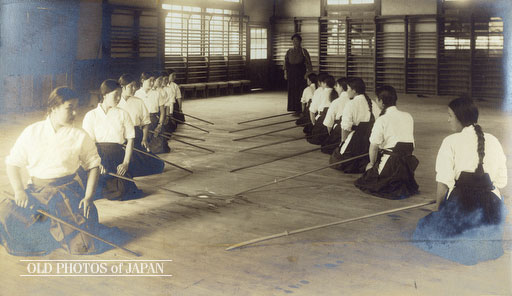
Naganita Class. Okayama City, 1935. Source: Old Photos of Japan.
Ding Number Seven and the Origins of White Crane Boxing
The historical records produced during the Ming and Qing dynasties contain a number of references to female martial artists. These sources clearly indicate that they were massively outnumbered by their male brethren, but as a category they were never entirely absent either. Of course “martial arts” as a conceptual category is a comparatively recent invention. Most of these individuals were identified and discussed using different professional markers. They were remembered as entertainers, vagabonds, criminals, healers, mystics, saints and in one memorable case even a rebel general. The fighting arts (and their related body of traditional physical culture) might play a role in each of these professions.
There are far fewer cases in which a woman was explicitly identified as a full time martial arts instructor with a large number of students. And I am aware of only a single a instance in which a historical woman was acknowledged by later male writers as the founder of area’s martial tradition. But before we can explore further we need to know something about the sorts of resources that are available to students of Chinese martial history.
“Gazetteers” are a fascinating historical resource for anyone interested in life in late imperial China. These records were by their nature both geographically bounded and technical. They might focus on a region, a province, a county, a city, a temple or even an important waterway. The ostensible point of a gazetteer was to gather the information that a busy outside government official or visitor might need to get up to speed on a new posting or assignment. As such these books are a valuable historical resource which provide maps, community histories, economic discussions, biographies of notable citizens and local color.
Members of the gentry were usually tasked with writing and editing the gazetteers. This was considered a prestigious assignment as the editor of such a volume had the ability to shape the local social and historical record. A review of these books shows that the families of the editors were inevitably remembered as “illustrious scholars” and “paragons of virtue.” It is important to take the social history that one finds in these books with a grain of salt, but they remain a vital resource for understanding local history in China.
The editors of these volumes usually went to some effort to put their best foot forward and appear as orthodox and socially respectable as possible. As a result gazettes often omit the sort of information that might be most useful to the historian of the martial arts.
Douglas Wile discovered a classic case of this while researching his landmark volume on the early Taiji literature (1996). The Wu brothers, who had important careers as high ranking public servants, were also gifted literary scholars. They put these skills to good use by editing the local county gazetteer after retiring from public office, as well as discovering, editing and preserving the oldest still existing manuscript tradition of what we now call the “Taiji Classics.”
In fact, all three brothers were deeply involved with and committed to, the practice of Taiji. It is thus odd that the historical volume that they edited contains no references to Taiji, or to the brothers other very substantial military exploits. Wile debates how we should interpret this silence. Was it some hint of sedition? Possibly. But a simpler explanation would be that a public airing of such an eccentric interest in a “dignified” source would bring embarrassment to the Wu family.
Marnix Wells has fared better with the use of gazetteers in his research. The county records that he dealt with in his investigation of Chang Naizhou not only preserved his memory, but it went into detail on the biographies of a number of other martial artists in the region. This is really about the best scenario that you can hope for. Yet in many cases these records simply pass over the martial arts in silence, not because they were actually absent, but rather because they were viewed as undignified or unorthodox by the volume’s editor.
The other difficult thing about gazetteers is finding and translating them. Localities were supposed to update these records regularly. Some did, while others were pretty lax. Nor is there a central clearing house for this information today. A few of these volumes (generally the ones for the more important areas) have been republished, but most of this information is still sitting in library stacks and private book collections in China. Actually getting ahold of all of the information that you would like to see, and successfully translating it, can be a major feat of scholarship in itself.
Luckily for us the editors of the late 17th century gazetteer for Yongchun County, Fujian Province, had no moral objections to the martial arts. We are also fortunate in that what he had to say was deemed important enough to warrant subsequent republishing and discussion, first by scholars in China, then by Stanley Henning in the United States.
Very often information about important martial artists (if any is included) will be found in the section on local biographies of noteworthy private citizens that most county gazetteers seem to have included. The brief account quoted by Henning and others states that during the Kangxi era (1662-1735) a woman named Ding Number Seven moved to Yongchun with her husband. Together they taught a number of individuals including 24 disciples. The most important of these was an individual named Zheng Li.
Zheng warranted his own entry in the volume. It focused on his immense strength and boxing skills. The discussions of his feats included a stereotyped defeat of a water buffalo (which he pulled the horns off of) and a shaolin monk (who later became a friend and teacher). Zheng was taught by Woman Ding, and he in turn provided instruction to most of the lineages that were still operating in the area at the time that the account was written.
So when does this account date to? We do not have an exact date, but we do have some clues. The list of southern gazetteers provided by James Tong indicates that Yongchun County did not update their records frequently (Disorder Under Heaven, 1992). As such it looks like this account might date to the 1684 edition of the local gazetteer. If these dates are correct than Ding Number Seven would have been active sometime between 1660 and 1680. Given that the account indicates as least two generations of instruction have passed, this would indicate that she was probably teaching in the 1660s.
Of course this account is also interesting for what is left out. We hear very little of her husband and his accomplishments. One wonders if perhaps she was included because she was both a martial artist and a “virtuous widow,” a group that always enjoyed recognition in these lists (see the discussion in Victoria Cass, 1999).
Nor do we know the name of the style that she taught. Today she is revered as the ancestor of Yongchun White Crane Boxing. Yet neither avian nor geographic nomenclature are mentioned in the account of her teaching, just the size of her school. Readers are also never told where she learned her art. Was it from her husband? Or possibly her father?
While the biographical account of Zheng Li is full of exaggeration and folklore (the defeat of a bull-type creature is one of the classic markers of a martial arts legend, as is a confrontation with a Shaolin monk) his teacher’s life lacks any fantastic elements. The account is all business, possibly too much so.
Subsequent versions of her story were more expansive and attempted to fill in these blanks. Perhaps the best-preserved account from this era is found in the Bubishi. This enigmatic work represents a Fujianese martial arts manuscript tradition dating from the last half of the 19th century. The manuscripts in question were preserved in Okinawa (hence the Japanese title), and went on to influence the development of that island’s indigenous fighting traditions.
The manuscripts included in the Bubishi are written in Chinese and include discussions of martial arts history, ethics, White Crane and Monk Fist styles, vital point strikes and traditional Chinese herbal medicines. The manuscripts are sometimes heavily illustrated and often appear without any specific order. An almost identical work entitled the Secret Shaolin Bronze Man Book was preserved by the Liu family in Fuzhou leading to the conclusion that the work was originally composed in China rather than Okinawa.
The volume begins its discussion of White Crane Kung Fu with the following story:
“In spite of his fighting skills in Monk Fist Boxing, Fang Zhonggong was no match for the scoundrels from a neighboring village who deceived and then viciously beat him while vying for control of his village. The injuries Fang sustained during the altercation were so severe that he was unable to fully recuperate and fell gravely ill. Attending to by his loving daughter and personal disciple, Fang Qiniang, his condition gradually deteriorated. No longer even able to eat, he finally died.
Deeply troubled by the loathsome circumstances of her beloved father’s death, Fang Qiniang vowed to take revenge. Although just a country girl from the rural village of Yongchun, Fang Qiniang was nevertheless a promising and spirited young woman. She longed to vindicate her family name, but she had not yet mastered the fighting skills her father was teaching her. She deeply pondered upon how she might find the power and strength to overcome such adversaries.
One day, not long after the tragedy, Fang was sobbing over the memory of her loss when suddenly she heard some strange noises coming from the bamboo grove just outside her home. Looking out the window to see what was making such a racket, she saw two beautiful cranes fighting. She noticed how the magnificent creatures strategically maneuvered themselves away from each others fierce attacks with remarkable precision. In the midst of piercing screams, the vigorous and lethal pecking was well concealed.
Deciding to frighten off the creatures, Fang went outside and grabbed the long bamboo pole she used for hanging clothes to dry. As she approached the cranes, Fang swung the pole but was unable to get close. Each time she attempted to swing or poke with the pole, they sensed her proximity, and, before the pole could reach its intended target, the birds instinctively evaded her every effort and finally just flew off.
Reflecting deeply upon this incident, Fang concluded that it was a revelation and soon set about evaluating the white cranes’ instinctive combat methods. If someone could fight the way the white cranes had, that person would be unbeatable. After considerable time and study, Fang finally came to understand the central principles of hard and soft and yielding to power. Fusing the central elements of Monk Fist gongfu with her own interpretation of the birds innate defensive movements she created a new style.
After three years of relentless training, Fang developed into an unusually skillful fighter. Capable of remarkable feats of strength and power, Fang Qiniang was no longer the weak and frail girl she once was. Her skills and determination finally gained her a notable reputation. Undefeated in those three years, Fang’s innovative style ultimately became one of the most popular civil self-defense traditions in and around Fujian Province, and became known as Yongchun White Crane Boxing.”
The Bubishi demonstrates that within two centuries the creator of Yongchun Boxing had evolved from a historical person with a number of personal students to a full blown initiatory figure with a martial arts mythology of her own. A comparison of the early account of “Ding” to the later stories of the woman “Fang” provides an excellent illustration of how it is that myths emerge and crystallize around the barest historical details. Note also how the questions posed by the short biographical sketch are systematically answered throughout the later extended story.
Rather than coming to the county with her paradoxically quiet husband, she is now attached to a father capable to teaching her Monk Fist Style. This certainly explains where Feng learned her art. Yet she did not teach Monk Fist to her students? Instead her father conveniently dies at the hands of bandits and she is forced to innovate to avenge the family name.
While the theme is a common one in martial arts legends, it still serves to introduce the vision of the fighting cranes that has been central to the development of martial arts in the Yongchun region. Further, Feng’s encounter with fighting cranes at her moment of greatest loss and despair shows an uncanny resemblance to Ng Mui’s later epiphany in the aftermath of the destruction of the Shaolin Temple.
Of course this new account raises its own set of questions. Did Feng use her new found martial prowess to carry out an act of bloody revenge? And what of the missing husband? Did she ever go on to marry? If not, why? Lastly, who was Feng Zhonggong? Given the abrupt start of the story it would appear that the Bubishi is only presenting a tantalizing fragment of what was once a longer narrative.
Current folklore, still in circulation among modern martial artists, has taken up each of these questions in turn. It takes no great leap of imagination to see Fang Zhonggong as an escapee from the ruins of Shaolin. This conclusion may even be implied in the 19th century fragment of the story that we still poses. He is obviously not a monk as he has married and has a daughter. Still, many lay Buddhists studied martial arts at Shaolin in both legend and fact. This would certainly seem to explain how he learned Monk Fist style in the first place.
His daughter’s use of the long pole in her attempt to scare off the noisy cranes is highly suggestive of the historic Shaolin pole fighting style. Lastly, the Bubishi claims that Feng always taught that it was only through the cultivation of inner peace and harmony that true martial mastery could be achieved. It also states that her ideas about this were handed down from the ancient past through her father and were not native to Fuzhou.
Modern readers have accepted this implied Shaolin connection without hesitation. Ng Ho reports that in some versions of the story Feng Qiniang refuses to marry, becomes a Buddhist nun herself, and changes her name to Yongchun (Wing Chun in Cantonese). In the end he concludes that from a folklore perspective “It is impossible to ascertain whether Fang Yongchun, Fang Qiniang and the nun Yongchun were one and the same person or three distinct individuals.” I agree with this basic conclusion that the myth takes a single identity and reworks it into multiple stories. To this list of overlapping stories we can also add the Abbess Ng Mui.
Historically speaking, the faded memory of Ding, a real martial arts instructor in Yongchun Village, has inspired the foundation myths of both Wing Chun and White Crane, as well as the individual legends of the Yim Wing Chun, Fang Yongchun, Fang Qiniang, and most recently the Nun Yongchun or Ng Mui. All four of these individuals probably represent different aspects of the same legendary figure.
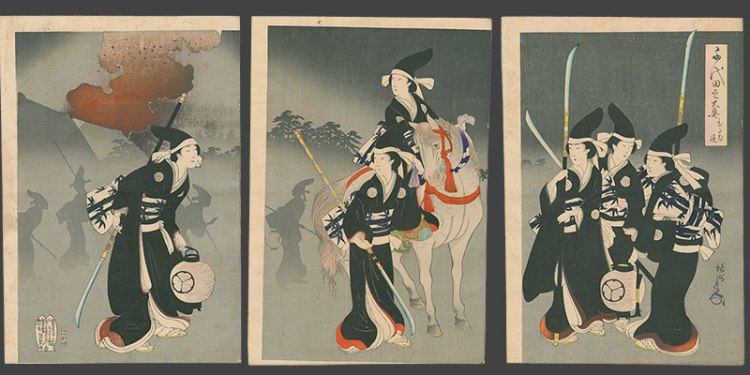
Women Naginata Warriors, Gaurdians of the Chiyoda Palace, Covering the Retreat from a Burning Castle. By Chikanobu, 1896.
Thinking About Female Martial Artists in the Late Imperial Period
How should we seek to situate the historic accounts of Woman Ding Number Seven? Just as importantly, how should we understand the evolution of her reputation over time? In what ways does the growth of this subsequent tradition illustrate the expectations and possibilities that female martial artists worked under?
The critical item to take away from the older account was that not only did some women seriously study the martial arts, but they might even have been reasonably expected to teach. The subsequent 19th century expansion of the original story can be viewed as an attempt to erase any ambiguity on that front. Ding’s husband was entirely erased from the memory of the White Crane system. Given the highly patriarchal nature of Chinese society, this is a fact that invites some careful consideration.
Victoria Cass has provided us with a simple three part typology for considering the different aspects of Chinese popular society in the late imperial period that a woman might be required to function in. While much of her volume, Dangerous Women (1999), focused on female mystics, martyrs and prostitutes, she also explicitly addressed martial artists and rebels. As such I think that this is a good starting point for thinking about Ding and her legacy.
Geography played a strong part in the popular imagination in both the Ming and Qing period. In fact, it became a sort of mental filing mechanism for various sorts of experiences, and subsequently different philosophies of the best way to achieve the “good life.” The three main geographic domains that seem to have captured the public imagination were the quaint villages of the countryside, the burgeoning cities of the south and rustic mountain retreats.
The lives of individual women can also be thought of as being structured by each of these domains. The small town was the stronghold of traditional morality. Women played a crucial role in the maintenance of this system.
Cass objects to the term “neo-Confucian” as it excludes too many important cultural elements (particularly as they pertain to the female members of the household). This was a social system that was ordered by the principals of hierarchy, loyalty and (most critically) sacrifice. Individuals were expected to sacrifice to show their fealty to the larger social structures, and in so doing they brought order to not only their own lives, but also to the entire community.
Sometimes (such as the through the suicide of a “virtuous widow”) this creation of good order was seen as taking place on a cosmic scale. Cass sees women as often fanatic participants in, and defenders of, what was essentially a dangerous cult. Specifically, it was dangerous because of the size of the sacrifices that social decorum could demand of any of its members at a moment’s notice.
It would not be hard to see Ding within this world. In fact, this is almost certainly the world that both she and the subsequent gazetteer editors inhabited. Whereas later accounts dismiss her husband, the clear implication in the original text is that she was married to a martial artist and moved to Yongchun because of him. These are the actions of an obedient wife. Her involvement with the martial arts might be seen as the sacrifice of a gentle life, and a certain vision of femininity, to the demands of the “family business.”
Admittedly these are probably are not the first ideas that would occur to most modern readers of this biographical sketch. Yet if Ding was to be included as an example of a “leading citizen” in a document like this, than she would have to conform to the stringent expectations of neo-Confucian orthodoxy. If she was widowed at a young age (as seems a likely possibility) it is probably worth noting that she doesn’t appear to have remarried or to have had children.
The second geographic domain is more urban. The city was the home of a new type of popular culture. Here men and women sought to build a different life based not on the idea of “sacrifice” but “authenticity.” Strong feelings and impulses were seen as the well spring of life, rather than something that needed to be placed on the altar of the family and the state.
More egalitarian relationships were forged in the home and more economically equal modes of production happened on the street. Urbanization saw the creation of a new class of town folk and merchant. Women in cities became merchants, writers, healers and teachers in great numbers. The city was often decried for its prostitution and “moral degradation,” but the truth was that it opened a wide variety of new economic opportunities for woman that had never been available in the countryside.
Female acrobats and martial artists occasionally performed in the streets. Likewise the early Republic saw a number of all female opera troops in southern China. There is some indication that Ding also succeeded in this commercial world. She had a large number of students for someone from a small village and her fame spread well beyond the borders of Yongchun.
The last geographic area is the mountain retreat. This is the realm of the recluse or mystic. Individuals retreated from the concerns to the world to follow the path of the dao, placing themselves in direct contact with strong natural currents. Cass argues that this trend was actually a direct outgrowth of the success of late imperial urbanization. In some way the mystical turn was a reaction against urbanization, but one that preserved the importance of “authenticity” as a central value.
Throughout the Ming and Qing periods mystics were thought to acquire magical powers through their isolation and devotion. Some were sought out as healers, while others became spiritual gurus. Some of the more eccentric ones were simply sought out as curiosities and highly prestigious dinner guests.
In the late 19th century mastery of the martial arts came to be closely aligned with this vision and the social values that went with it. This transition is actually pretty evident in the history and folklore of the hand combat systems. Early in the 19th century much of the martial arts seem to revolve around the need for sacrifice to defend the village from concrete physical threats. As the threats of the late 19th century became more metaphysical in nature, the martial arts took to the mountains, metaphorically speaking. Early in the 1800s a highly desired teacher might have been a military trainer or a distinguished veteran. But by the end of the 19th century only a secluded mystic would do. If they claimed a Shaolin heritage, so much the better.
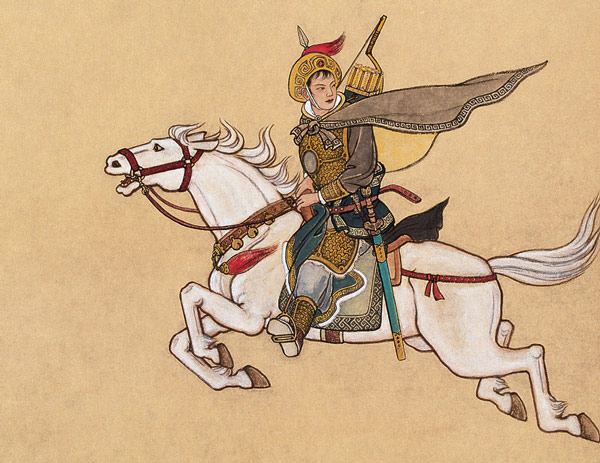
A painting of Hua Mulan. Source: Wikimedia.
Again, there were older cultural precedents that one could draw on in the construction of this vision of martial virtue. Consider for instance the archaic story of the Maiden of Yue, which was discussed in martial circles throughout the Ming and Qing:
“[An advisor speaking to his King]….I hear there is a young woman of Yue who came from the Southern Forests; the people of Yue speak highly of her. I think your Majesty should send her an invitation and you can see for yourself how good she is.’
So the King of Yue sent an emissary with a polite invitation to ask whether the King could get her advice on skill in use of swords and halberds.
The Young Woman of Yue traveled north for her audience with the king. On the way, she men an old fellow who said his name was ‘Old Mr. Yuan.’
He said to the young woman, ‘I hear you fight well with a staff. I’d like to see a demonstration.’
She replied, ‘I wouldn’t presume to keep anything from you: you are welcome to test my skill, Sir.’
So Old Man Yuan drew out a length of Linyu bamboo. But the bamboo was rotten at one end. The end fell to the ground and the young woman immediately snatched it up. The old man wielded the top end of the staff and thrust towards the young woman, but the girl parried straight back, thrust three times and finally raised her end of the bamboo and drove home her attack against Old Man Yuan. Old Man Yuan hopped off up a tree, turning into a white ape. Then each went their own way, and she went to meet the King.
The King asked her, ‘of all the methods of fighting with the staff which is the best?’
She answered, ‘I was born in the depths of the forest and I grew up in the wilds where no other people ever ventured. So there was no “method” for me and I followed no course of instruction, for I never ventured into the feudal fiefs. Secretly I yearned for a true method of fighting and I practiced endlessly. I never learned it from anyone: I just realized one day that I could do it.’
‘And what method do you practice now?’ asked the King.
‘The method involves great mystery and depth. The method involves “front doors” and “back doors” as well as hard and soft aspects. Opening the “front door” and closing the “back door” closes off the soft aspect and brings the hard aspect to the fore.
‘Whenever you have hand-to-hand combat, you need to have nerves of steel on the inside, but be totally calm in the outside. I must look like a demure young lady and fight like a startled tiger. My profile changes with the action of my body, and both follow my subconscious. Overshadow your adversary like the sun; but scuttle like a flushed hare. Become a whirl of silhouettes and shadows; shimmer like a mirage. Inhale, exhausting, moving in, moving back out, keeping yourself out of reach, using your strategy to block the adversary, vertical, horizontal, resisting, following, straight, devious, and all without sound. With a method like this one man can match a hundred; a hundred men can match ten thousand. If Your Majesty wants to try me out, you can have a demonstration right away.’
The King of Yue was overjoyed and immediately gave her the title ‘Daughter of Yue.’ Then he ordered the divisional commanders and crack troops to practice the new method so that they could pass on their skills to the troops. From then on, the method was known as ‘The Daughter of Yue’s Swordsmanship.’”
Translation by Stephen Selby.
Chinese Archery. Hong Kong University Press. 2000. pp.155-157
As the biography of the Woman Ding Number Seven evolved into the tale of the tale of “Fang”, daughter of a “Shaolin monk,” other literary patterns and inspirations were brought in to enrich the mix. Notice for instance how in the later version of the story Fang uses a pole in a test of skills with a heavenly animal, much like Maiden of Yue in the ancient account. Both of them are without a male protector, and both are left to their own devices to devise a system of defense that will work for a woman. In so doing they both reveal the fundamental principles and philosophy behind the Chinese martial arts. And while Ding may have started off in the heart of a village surrounded by students, Fang, like her ancient predecessor, inhabits the wilderness. In her later literary guises he even takes up residence at “White Crane Temple” in the mountains.
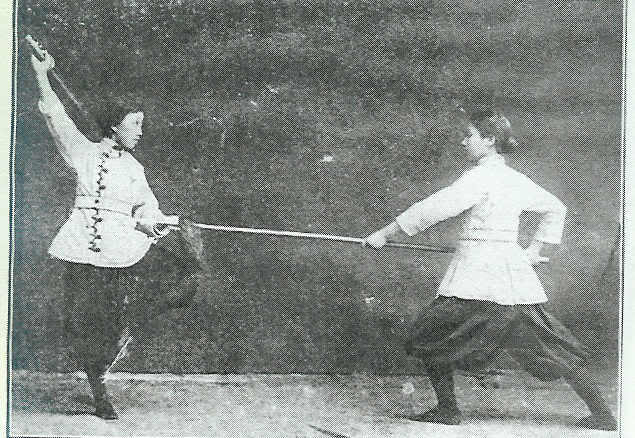
A photo of female martial artists from the Jingwu Anniversary Book. The woman on the left is Chen Shichao, one of the most vocal campaigners for the equality of female martial artists within Jingwu. She toured China and south east Asia promoting female involvement in the martial arts.
Conclusion
In future installments of this series I would like to take a closer look at some of the prominent female martial artists and reformers of the Republic period. But to do that it is first necessary to gain a better understanding of the historic roles that such individuals have actually played. Our examination of Woman Ding demonstrates that while not common, important female martial artists did exist in the late imperial period and that they could be remembered as foundation figures.
Still, the progression from “Woman Ding” to “Feng” suggests that there has always been a strong tendency to understand and frame these discussions within larger archetypal narratives. Changes in Chinese popular culture account for not only the drastic increase in stories about female martial artists in the late Qing and Republic era, but also the way in which those stories evolved. Rather than seeing women warriors as a bulwark of neo-Confucian values, they are increasingly perceived as guardians of a transcendent set of truths about Chinese identity and the true nature of power. These were topics that generated much anxiety at the time.
This narrative potential had been present for centuries. Indeed the story of the Maiden of Yue was told in many places during the Ming dynasty. But it wasn’t until the more existential challenges of the early 1900s that this vision became a popular mode of social expression.
The groundwork has now been set for a monumental shift. Not only will the social reforms of the late Qing and Republic era bring more women into the martial arts than ever before, but they will also be inheriting a very specific set of cultural expectations. They will be seen as both guardians of the essence of Chinese culture and potential reformers in the face of serious threats to that tradition. A number of female martial artists during the 1920s and 1930s will seek to seize this banner.
Found:
HERE
